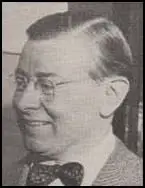Frank Sullivan

In the early 1920s Sullivan was associated with those involved in the Algonquin Round Table. Other members included Robert E. Sherwood, Dorothy Parker, Robert Benchley, Alexander Woollcott, Heywood Broun, Harold Ross, Donald Ogden Stewart, Edna Ferber, Ruth Hale, Franklin Pierce Adams, Jane Grant, Neysa McMein, Alice Duer Miller, Charles MacArthur, Marc Connelly, George S. Kaufman, Beatrice Kaufman, Frank Crowninshield, Ben Hecht, Frank Sullivan, John Peter Toohey, Lynn Fontanne, Alfred Lunt and Ina Claire.
Harold Ross, Jane Grant and Raoul Fleischmann established the The New Yorker in 1925. Sullivan had his first article published in the magazine in January, 1926. Other contributors included Dorothy Parker (poems and short-stories), Robert Benchley (theatre critic), James Thurber (cartoons and short-stories), Alexander Woollcott, Elwyn Brooks White, John McNulty, Joseph Mitchell, Katharine S. White (also fiction editor), Sidney J. Perelman, Janet Flanner (correspondent based in Paris), Wolcott Gibbs (theatre critic), St. Clair McKelway and John O'Hara (over 200 of his short-stories appeared in the magazine).
Sullivan was close to Dorothy Parker. He later recalled that when she broke up with John McClain she phoned him up: "She was all woe over the phone. She told me she had had a row with John McClain, and she said, 'I've had to get away from it all... You're the only person I'd like to see. You come up. Say nothing to anyone. Come to the Plaza this afternoon and have a drink with me.' So of course I sprang to the call. You always sprang to the call when Dottie needed you."
Sullivan was known for his collection of fictitious characters including: Aunt Sally Gallup, Martha Hepplethwaite, the Forgotten Bach, and Mr. Arbuthnot, the cliché expert. One of his colleagues later recalled: "The main thing about Frank Sullivan, of course, is that he was terrifically funny. His pieces were short and bright and apparently offhand. They looked easy, and maybe only writers really understand how special they were, and how hard to do."
Frank Sullivan, who never married, died in Saratoga Springs, on 19th February, 1976.
Primary Sources
(1) The New Yorker (3rd March, 1976)
The main thing about Frank Sullivan, of course, is that he was terrifically funny. His pieces were short and bright and apparently offhand. They looked easy, and maybe only writers really understand how special they were, and how hard to do.
